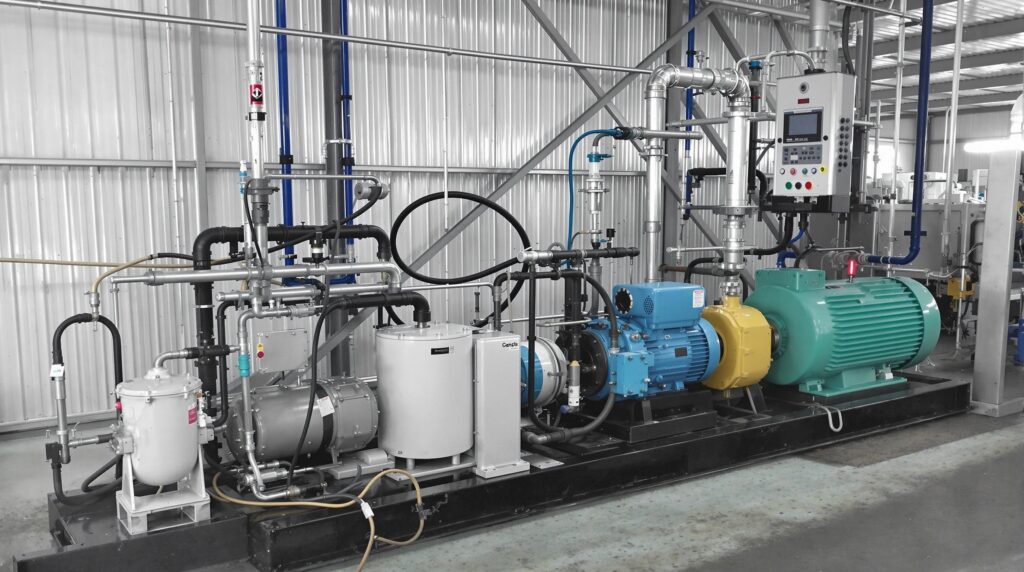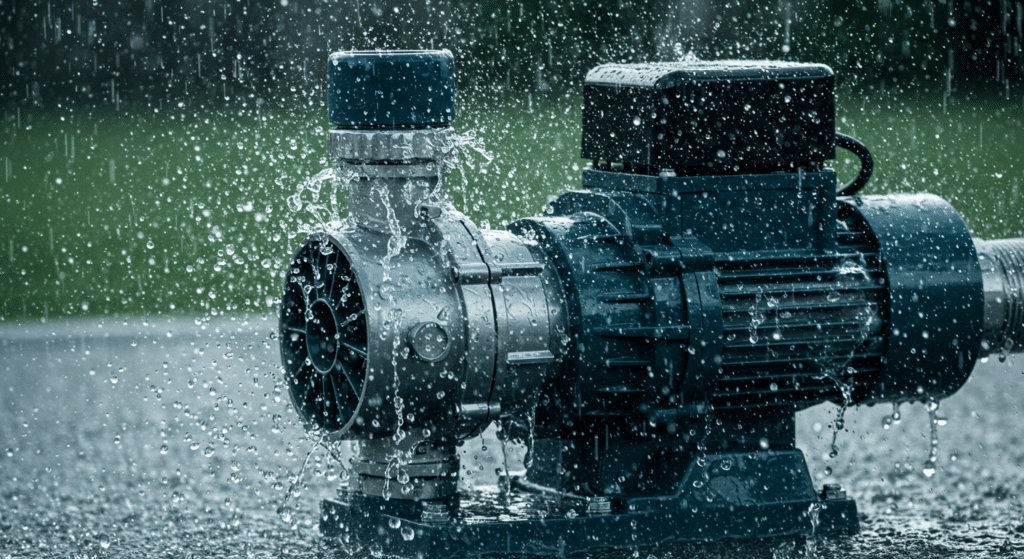Fluid handling applications across various industries face numerous challenges, from maintaining sterility to pumping viscous or corrosive fluids. Choosing the wrong pump can lead to contamination, leakage, and frequent maintenance, resulting in costly downtime and reduced efficiency.
Peristaltic pumps offer a unique solution to these challenges, thanks to their distinctive operating principle that ensures gentle, pulsation-free flow without any contact between the pump and the fluid. By employing a simple yet effective design, peristaltic pumps overcome the limitations of traditional pump types, making them ideal for a wide range of applications.
In this comprehensive guide, we’ll dive into the world of peristaltic pumps, exploring their components, types, and operating principles. We’ll also discuss their advantages, disadvantages, and key considerations for selecting the right pump for your specific application.

What Is a Peristaltic Pump
A peristaltic pump is a type of positive displacement pump that uses alternating compression and relaxation of a flexible tube to move fluids. The pumping action is similar to peristalsis, the contraction and relaxation of muscles that helps move food through the digestive tract. This unique pumping mechanism allows peristaltic pumps to handle a wide variety of fluids gently and efficiently.
Concept of Positive Displacement
Peristaltic pumps fall under the category of positive displacement pumps. In a positive displacement pump, a fixed volume of fluid is displaced or moved with each cycle of the pump’s operation. This is achieved by trapping a certain amount of fluid and forcing it to flow through the pump into the discharge pipe. Positive displacement pumps provide a constant flow rate at a given speed, regardless of the discharge pressure, making them ideal for applications requiring precise dosing or metering.
Components of Peristaltic Pumps
The main components of a peristaltic pump include:
- Flexible Tubing: The heart of a peristaltic pump is the flexible tubing through which the fluid is pumped. The tubing is typically made of materials like silicone, PVC, or other elastomers that can withstand repeated compression and relaxation.
- Rotor and Rollers/Shoes: The rotor is a circular component with two or more rollers or shoes attached to its circumference. As the rotor turns, the rollers or shoes compress the flexible tubing, creating a seal between the suction and discharge sides of the pump.
- Pump Casing: The pump casing or housing encloses the rotor and tubing, providing protection and support. The casing also includes the inlet and outlet ports for the fluid.
- Motor: Peristaltic pumps are driven by an electric motor, which can be AC or DC depending on the application. The motor speed determines the flow rate of the pump.
How Peristaltic Pumps Operate
The pumping action in a peristaltic pump is achieved through the following steps:
- The flexible tubing is inserted into the pump casing, forming a loop around the rotor.
- As the rotor turns, the rollers or shoes attached to it compress the tubing, creating a seal between the suction and discharge sides.
- The rotation of the rotor causes the point of compression to move along the length of the tubing, drawing fluid in behind the compressed section and pushing it in front.
- As the rotor continues to turn, new fluid is sucked into the tubing while the previously drawn fluid is discharged from the pump.
This process is repeated continuously, creating a steady flow of fluid through the pump. The flow rate is proportional to the speed of the rotor and the size of the tubing.

Types of Peristaltic Pumps
There are three main types of peristaltic pumps:
Tube Pumps
Tube pumps, also known as laboratory or low-flow peristaltic pumps, are the most common type. They use small-diameter, flexible tubing (typically less than 8 mm) and are designed for lower flow rates and pressures. Tube pumps are widely used in laboratory, medical, and biotech applications for precise dosing and metering of fluids.
Hose Pumps
Hose pumps, also called high-flow or industrial peristaltic pumps, use larger-diameter, reinforced hoses (typically 10-25 mm) and are designed for higher flow rates and pressures. The hoses are often made of materials like Norprene or Marprene, which offer greater durability and resistance to chemicals. Hose pumps are commonly used in industrial applications such as wastewater treatment, chemical processing, and mining.
Microfluidic Pumps
Microfluidic pumps are specialized peristaltic pumps designed for handling extremely small volumes of fluids, typically in the microliter or nanoliter range. These pumps use miniaturized components and very small-diameter tubing (often less than 1 mm). Microfluidic pumps are used in applications such as drug discovery, point-of-care diagnostics, and lab-on-a-chip devices.
Flow Rate Calculations for Peristaltic Pumps
The flow rate of a peristaltic pump can be calculated using the following formula:
Q = n × V
Where:
- Q = Flow rate (mL/min)
- n = Rotor speed (rpm)
- V = Volume per revolution (mL/rev)
The volume per revolution depends on the tubing size and the number of rollers or shoes on the rotor. Manufacturers typically provide flow rate charts or calculators to help users determine the appropriate tubing size and rotor speed for their desired flow rate.
Advantages of Peristaltic Pumps
Gentle Handling of Fluids
The peristaltic pumping action is gentle and non-invasive, making it suitable for handling delicate fluids such as cell cultures, blood, and other biological samples. The fluid only contacts the inside of the tubing, minimizing the risk of contamination or damage.
Low Maintenance
Peristaltic pumps have few moving parts and the fluid only contacts the tubing, reducing wear and tear on the pump components. This results in lower maintenance requirements and longer service life compared to other pump types.
Reversible Flow
By reversing the direction of the rotor, peristaltic pumps can easily change the direction of fluid flow. This bidirectional capability is useful in applications that require emptying lines or clearing blockages.
Self-Priming
Peristaltic pumps are self-priming, meaning they can draw fluid up from a source even when the pump is dry. This eliminates the need for manual priming or additional priming systems.
Dry Running Capability
Unlike some other pump types, peristaltic pumps can run dry without damage. If the fluid supply runs out, the pump can continue operating without risk of seizing or overheating.
Disadvantages of Peristaltic Pumps
Limited Pressure Capability
Peristaltic pumps typically have lower pressure capabilities compared to other positive displacement pumps like gear or piston pumps. The maximum pressure is limited by the strength of the tubing material and the compression force of the rollers.
Pulsating Flow
The peristaltic pumping action creates a slight pulsation in the fluid flow, especially at lower speeds. This pulsation can be minimized by using more rollers or a longer compression zone, but it may not be suitable for applications requiring extremely smooth flow.
Tubing Wear
The repeated compression and relaxation of the tubing can cause it to wear out over time, requiring periodic replacement. The tubing life depends on factors such as the material, fluid properties, and operating conditions.
Lower Efficiency
Peristaltic pumps generally have lower energy efficiency compared to other pump types due to the friction between the rollers and tubing. This can result in higher power consumption and operating costs.
Applications of Peristaltic Pumps
Chemical Dosing
Peristaltic pumps are widely used for chemical dosing in water and wastewater treatment, swimming pools, and industrial processes. They provide accurate, repeatable dosing of chemicals such as chlorine, pH adjusters, and flocculants.
Biomedical and Pharmaceutical
In medical and biotech applications, peristaltic pumps are used for fluid handling tasks such as blood circulation, dialysis, and drug delivery. Their gentle pumping action and ability to handle delicate fluids make them well-suited for these applications.
Food and Beverage
Peristaltic pumps are used in food and beverage processing for tasks such as ingredient dosing, flavor injection, and product transfer. The pumps can handle viscous fluids like syrups and pastes, and their sanitary design helps maintain product quality.
Printing and Ink Delivery
In the printing industry, peristaltic pumps are used for ink delivery systems in inkjet printers and other digital printing equipment. The precise flow control and ability to handle pigmented inks make them a popular choice for this application.

How to Select the Right Peristaltic Pump
When choosing a peristaltic pump for a specific application, several key factors should be considered:
Flow Rate and Pressure Requirements
The first step is to determine the required flow rate and discharge pressure for the application. This will help narrow down the pump size and tubing diameter needed. Consult the manufacturer’s flow rate charts or use their online sizing tools to select a pump that meets your requirements.
Viscosity of Fluid
The viscosity of the fluid being pumped is another important consideration. Higher viscosity fluids require more powerful motors and may limit the maximum flow rate achievable. Make sure the pump is capable of handling the viscosity range of your application.
Chemical Compatibility of Fluid with Pump Materials
The tubing and other wetted parts of the pump must be compatible with the fluid being pumped. Check the chemical resistance charts provided by the manufacturer to ensure the tubing material can withstand the fluid without degradation or leaching. Consider factors such as temperature, concentration, and exposure time when evaluating compatibility.
Comparing Peristaltic Pumps with Other Pump Types
| Pump Type | Advantages | Disadvantages |
|---|---|---|
| Peristaltic | – Gentle handling – Low maintenance – Reversible flow – Self-priming – Can run dry | – Limited pressure – Pulsating flow – Tubing wear – Lower efficiency |
| Centrifugal | – High flow rates – Low maintenance – Smooth flow – Compact design | – Not self-priming – Cannot run dry – Poor low-flow performance – Limited viscosity handling |
| Gear | – High pressure – Precise dosing – Can handle high viscosity – Compact design | – Not self-priming – Cannot run dry – Requires maintenance – Potential for fluid contamination |
| Diaphragm | – Self-priming – Can run dry – Handles solids – High pressure | – Pulsating flow – Requires maintenance – Limited flow rates – Noisy operation |
Common Issues and Troubleshooting
- Tubing Failure: If the tubing ruptures or leaks, stop the pump immediately and replace the tubing. Check for signs of wear, obstruction, or chemical attack.
- Reduced Flow Rate: A decrease in flow rate may indicate a blockage in the tubing or a worn rotor. Inspect the tubing for kinks or obstructions and clean or replace as needed. Check the rotor for signs of wear and replace if necessary.
- Noisy Operation: Unusual noise during operation can indicate a problem with the pump. Check for debris in the pump head, a loose rotor, or worn bearings. Consult the manufacturer’s troubleshooting guide for specific instructions.
- Motor Overheating: If the motor overheats, it may indicate a problem with the power supply or an obstruction in the pump. Check for proper voltage and current, and inspect the tubing and rotor for any blockages or binding. Allow the motor to cool before restarting.






